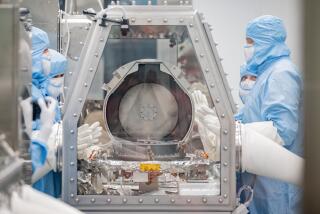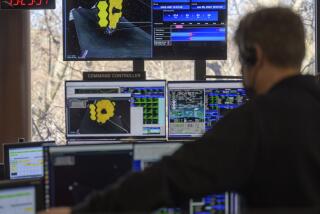Astronauts start spacewalk series to fix cosmic ray detector
- Share via
CAPE CANAVERAL, Fla. — Astronauts launched an extraordinarily complicated series of spacewalks Friday to fix a cosmic ray detector at the International Space Station.
Armed with dozens of dissecting tools, Italian astronaut Luca Parmitano removed two protective covers to gain access to the inside of the Alpha Magnetic Spectrometer. He handed them to his U.S. spacewalking partner, American Andrew Morgan, for tossing overboard.
“OK, 3-2-1, release,” Morgan said as he let go of the 4-foot-long shield high above the Pacific.
Later, over the South Atlantic, Morgan ditched the second, smaller cover. “Another great pitch,” Mission Control radioed.
These latest pieces of space junk pose no danger to the orbiting lab, according to NASA. The larger shield should remain in orbit a year or so before reentering the atmosphere and burning up. The smaller one should reenter in a few weeks.
NASA considers these spacewalks the most difficult since the Hubble Space Telescope repairs a few decades ago. Unlike Hubble, the spectrometer was never meant to undergo space surgery. After 8½ years in orbit, its cooling system is almost dead.
Parmitano and Morgan will go out at least four times this month and next to revitalize the instrument. Their second spacewalk is next Friday.
Delivered to orbit by Endeavour in 2011 on the next-to-last space shuttle flight, the $2-billion spectrometer is hunting for elusive antimatter and dark matter.
It’s already studied more than 148 billion charged cosmic rays. That’s more than what was collected in over a century by high-altitude balloons and small satellites, said lead scientist Samuel Ting, a Nobel laureate at MIT. He monitored Friday’s 6½-hour spacewalk from Mission Control in Houston.
The huge spectrometer — 16 feet by 13 feet by 10 feet with a mass of 7½ tons — was designed to operate for three years. By installing four new and improved coolant pumps, the astronauts can keep it working throughout the life of the space station, or another five to 10 years. The replacement pumps arrived at the space station nearly two weeks ago, along with an assortment of new tools.
Parmitano, the lead spacewalker, and Morgan trained extensively for the plumbing job before rocketing into orbit in July. They hustled through Friday’s cover removals and even got a jump on future chores.
Next week’s spacewalk will involve slicing through stainless-steel tubes and splicing in connections for the new pumps, which like the old will use liquid carbon dioxide as the coolant.
In some respects, this work, 250 miles up, is even trickier than the Hubble spacewalks, said NASA project manager Ken Bollweg. As before, the stakes are high.
“Any time you do heart surgery you’re taking some risks,” Bollweg said in an interview this week.
Morgan is an emergency physician in the Army — a bonus for this kind of intricate work. He’s making his first spaceflight.
For second-time station resident Parmitano, the occasion marked his return to spacewalking following a close call in 2013. He almost drowned when his helmet flooded with water from the cooling system of his spacesuit. Unable to talk because of the rising water, he managed to keep calm as he made his way back to the safe confines of the space station.
More to Read
Sign up for Essential California
The most important California stories and recommendations in your inbox every morning.
You may occasionally receive promotional content from the Los Angeles Times.










